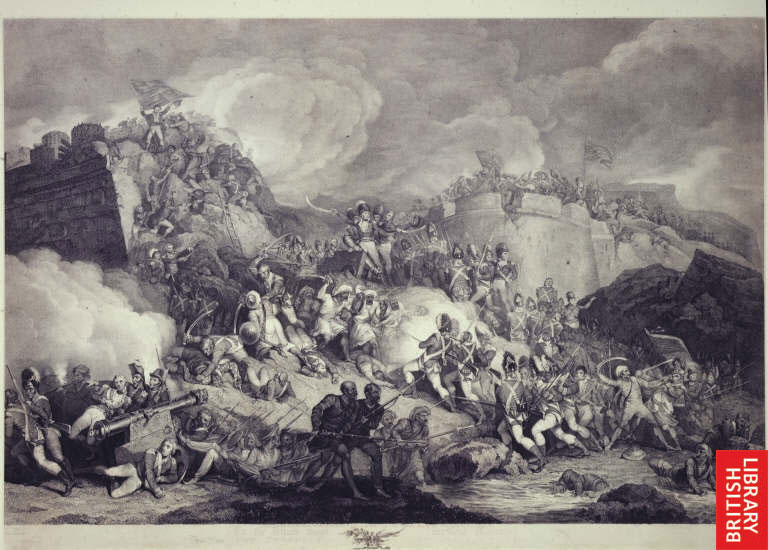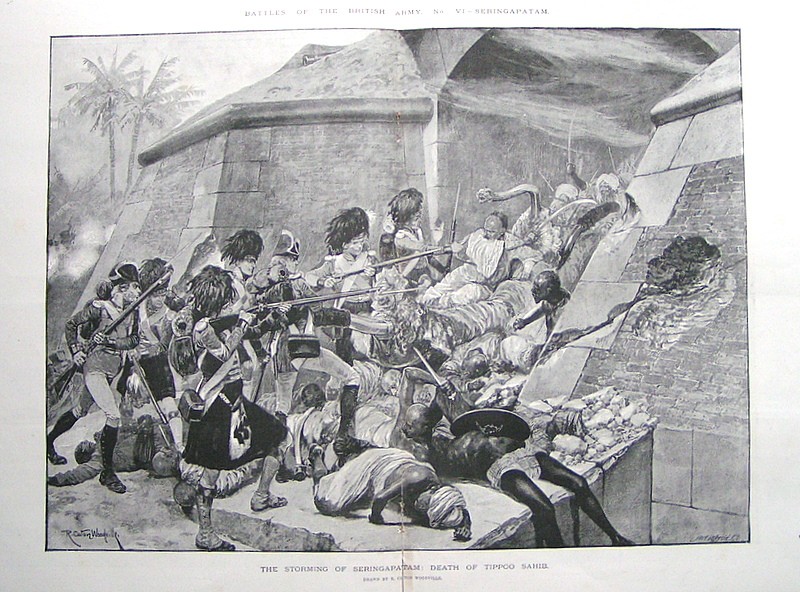




*"The storming of Seringapatam," an engraving by John Vendramini, 1802* (BL)

A Qajar Persian copy of a British painting of the assault, 1836/7
Source:
http://search.sothebys.com/jsps/live/lot/LotDetail.jsp?lot_id=4FGKH
(downloaded May 2005)
" THE ASSAULT AND TAKING OF SERINGAPATAM AFTER THE PAINTING BY HENRY SINGLETON, SIGNED "THE SLAVE OF THE KING, 'ABDULLAH", QAJAR, PERSIA, DATED 1252 HIJRA / A.D.1836-7; oil on canvas, framed
CATALOGUE NOTE: inscription in Persian:
"The assault and capture of the fortress of Seringapatam, which is the capital of the Deccan on 4th May 1799 corresponding to 1214 of the hijra. Major General Baird divided his army into two [divisions], giving a part to Colonel Dunlop. Despite extreme bravery and stability shown by the garrison-soldiers and the fact that Colonel Dunlop was injured, nevertheless, the British army with absolute gallantry, arrows and swords entered the fortress at which point Tipu Sultan was killed and the fortress captured.The signature conforms to that used by 'Abdullah, the chief painter at the court of Fath 'Ali Shah. 'Abdullah went on to receive the title bashi (chief) and khan from Muhammad Shah in 1255/1844 and was put in charge of all craftsmen working for the royal palace. Karimzadeh notes that not many works by 'Abdullah are recorded; in style, he followed Mihr 'Ali, and worked both in oil and watercolour (Karimzadeh Tabrizi, M. A., The Lives and Art of Old Painters of Iran, vol. 1, London, 1985, pp.301-11).The slave of the king, 'Abdullah, wrote it, the year 1252 (1836-7)"
According to Karimzadeh, 'Abdullah was particularly skilful in depicting battle scenes and portraiture, as witnessed by the large painting of "Fath 'Ali Shah receiving dignitaries". Amongst those depicted in the aforementioned painting is the "envoy of the great Ray (Raja) Tipu Sultan", showing that Tipu was certainly known at the Qajar court, though it is unlikely that Muhammad Shah would have been sufficiently interested in the British victory at Seringapatam to commission a painting of the subject. A more plausible explanation is that one of the British envoys under Muhammad Shah who knew 'Abdullah commissioned him to paint this picture. The composition relates closely to an oil painting by the British artist, Henry Singleton (1766-1839), now in the Allentown Art Museum, Pennsylvania (Archer, M., India and British Portraiture 1770-1825, London 1979, pl.342) which 'Abdullah must have known through a coloured engraving."
*"Last effort of Tippoo Saib at Seringapatam," an engraving from a history book, 1851*
Source: ebay, Apr. 2007

*"Tippou Saib leading his troops to the defense of Seringapatam"; an engraving, 1902*
Source: ebay, Dec. 2005

A cannon used in the assault on Seringapatam
Source: http://www.sandhurstfoundation.org/ScenesSandhurst.asp
(downloaded June 2005)
== Indian Routes index == Indian Routes sitemap == Glossary == FWP's main page ==